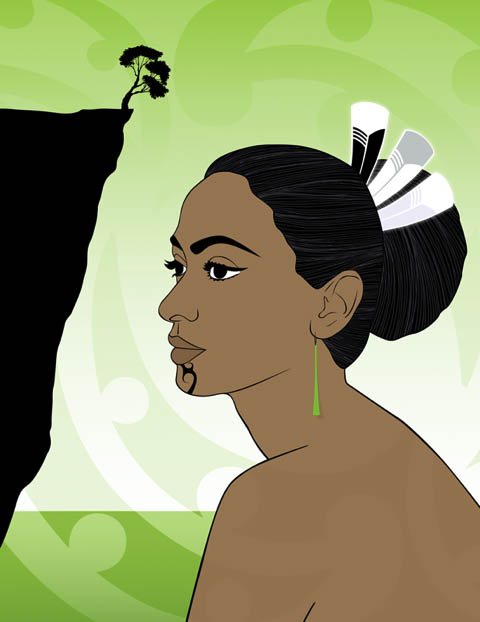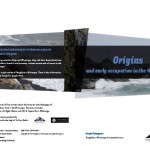NA KO PA-MARAMARAMA te ingoa o te pa o te hoa o Te Aohuruhuru. He koroheke te tangata nei, ko tana wahine he tutua, he mea tango mai e ia i te tangata i arohatia nuitia e tenei wahine. Ko te take i tangohia ai e ia te wahine nei he pai, he ataahua, he wahine momoho ki te mahi. Ko te mahi he taka kai, he whatu weruweru mo te koroheke nei. Otira ko tona noho, e noho pononga ana ki tenei koroheke, otira ko tona aroha pea e mau tonu ana ki te tangata i arohatia nuitia e ia.
A roa rawa tona nohoanga ki tenei koroheke, a muri iho ka tahuri taua koroheke ki te hakirara i a ia.
Ko te tikanga tenei o tana hakiraratanga i a ia. No to raua moenga i te po, roa rawa raua e moe ana, ka maranga taua koroheke ki runga, ka titiro ki tana wahine tamahine, kua warea e te moe. Ko ona pakikau kua pahuhu ke ki raro i te kowhananga a nga ringaringa, a nga waewae, i te ainga a te ahuru. Katahi ka tahuna e ia te ahi, ka ka te ahi, ka tirohia e ia nga pakikau, ka takoto kau ia. Katahi ka mahara te koroheke ra ki te nuinga o tona pai. Kowatawata ana nga uru mawhatu i te hana o te ahi; ko tona tinana, ngangana ana: ko tona kiri, karengo kau ana; ko te kanohi, ano he rangi raumati paruhi kau ana; ko te uma o te kotiro e ka whakaea, ano he hone moana aio i te waru e ukura ana hoki i te toanga o te ra, ka rite ki te kiri o tuawahine.
Taro rawa te tirohanga o taua koroheke ki te pai o tana wahine tamahine, muri iho ka whakaarahia e ia ona hoa koroheke o roto i te whare ki te matakitaki ki te ataahuatanga o tana wahine. I a ratou e matakitaki ana i a ia, katahi ano ia ka oho. Oho rawa ake ia, koia e matakitakina ana e te tini koroheke o roto i te whare ra.
Heoiti ano ka maranga te wahine ki runga, ka mate i te whakama. Heoti ano ko te rangi i pai ra kua tamarutia e te pokeao; ko te uma kakapa ana, ano e ru ana te whenua. Ka tinia ia e te whakama. Katahi ka rarahu nga ringa ki nga pakikau, ki te uhi i a ia. Katahi ka rere ki te kokinga o te whare; ka tangi, tangi tonu a ao noa te ra.
Awatea kau ana, ka haere te koroheke ra ratou ko nga hoa, ka eke ki runga i te waka, ka hoe ki waho ki te moana ki te hi. A i muri o te koroheke ra ratou ko nga hoa kua riro, katahi te wahine nei ka whakaaro ki te he o tana tane ki a ia, katahi ka mahara kia haere ia ki te whakamomori. Na, tera tetahi toka teitei e tu ana i te tahatika, ko te ingoa o tenei toka inaianei ko Te Rerenga o Te Aohuruhuru.
Katahi te tamahine ka tahuri ki te tatai i a ia, na ka heru i a ia, na ka rakei i a ia ki ona kaitaka, ka tia hoki i tona mahunga ki te raukura—ko nga raukura he huia, he kotuku he toroa, ka oti. Katahi ano te tamahine ka whakatika, na ka haere, ka piki, a ka eke ki runga o te toka teitei, ka noho. Katahi ano ka kohuki te whakaaro o te tamahine ki te tito waiata mana.
Ka rite nga kupu o taua waiata; ko te tane ratou ko nga hoa kei te hoe mai ana ki uta. Ka tata mai te waka o te tane ki te taketake o te toka e noho ra te tamahine i runga, ko te koroheke nei kua pawera noa ake te ngakau ki te purotutanga o tana wahine taitamariki. Katahi ratou ka whakarongo ki te wahine ra e waiata ana i tana waiata. Ka rongo ratou ki nga kupu o te waiata a te wahine ra. Ano!
torino kau ana mai i runga i te kare o te wai, ano te ko e pa ana ki tetahi pari, na ka whakahokia mai, ano te mamahutanga ki tona koiwi. Ana! Koia ia, ko te hou o te waiata a tuawahine, mataaho mai ana ki nga taringa. Koia tenei:
‘Naku ra i moe tuwherawhera,
Ka tahuna ki te ahi
Kia tino turama,
A ka kataina a au na.’
Na ka mutu tana waiata, katahi ia ka whakaangi i taua toka nei ki te whakamoti i a ia. Katahi ka kite mai taua koroheke ra i a ia ka rere i te pari. I kitea mai e ia ki nga kakahu ka ma i tona rerenga ai.
Katahi ka whakau mai to ratou waka ki te take o te toka i rere nei te wahine nei, ka u mai, u noa mai ka kite ratou i a ia e takoto ana, kua mongamonga noa atu. Ko te waka whakairo nei kua paea ki te akau, kua pakaru rikiriki. A kua ngahae hoki te waka whakairo a tenei koroheke, ara te pai whakarere rawa atu o te tamahine nei. A mohoa noa nei maharatia tonutia e matou te ingoa o tera toka ko Te-Rerenga-o-Te-Aohuruhuru. A maharatia tonutia hoki e matou nga kupu o tana waiata. No te taenga mai hoki o nga tauhou ki konei, ka arahina ratou e matou ki te toka nei kia kite.
PAMARAMARAMA WAS THE NAME of the pa in which lived the husband of Te Aohuruhuru. He was an old man. His wife, a girl of lowly birth, had been taken by him from one she loved dearly, because of her excellence, her beauty, and her accomplishments. She was skilled in all kinds of cooking and in weaving the finest mats for her old husband. But she lived the life of a slave with the old man, her heart still yearning for the loved one from whom she had been torn.
She had been so living with her old husband for a considerable time when he turned to annoying and insulting her, and this is how he set about it.
When they were in bed one night the old man woke and looked at his girl wife, who lay there fast asleep. Owing to the excessive heat, her garments had slipped down from the restless tossing of her arms and legs. He made a fire, and by its blaze he saw the clothes and his wife lying bare. Then he began to gloat over his good fortune. Gleaming were her curly tresses in the firelight, her body glowing, her skin smooth and pearly, her eyes fine and clear like a beautiful summer’s day. Her breasts rose and fell like a peaceful sea in summer lit up by the rays of the setting sun. Such was the appearance of the girl as she lay there. After the old man had spent some time in feasting his eyes on his beautiful girl wife he awakened his old cronies in the house to share in gazing upon her lovely form. While they stood looking at her she awoke to find herself being stared upon by a crowd of old men in the house. Springing up from the bed she hung her head in shame. The beautiful summer’s day had been covered by a dark cloud. Her breast quivered and throbbed as does the earth when shaken by an earthquake. She was overcome by shame and, seizing her garments to hide her body from their wicked gaze, she rushed to the furthest corner of the house and sobbed her heart out until day break.
When morning had come, the old man and his friends had embarked on their canoe and paddled out to sea to catch fish. Thereupon the girl, brooding over the insult to which her husband had subjected her, determined to end her life. There is a lofty crag standing near the shore, which is now known as Te Rerenga o te Aohuruhuru (the leaping place of Te Aohuruhuru). Then the girl decked herself out, combed her tresses, put on her best mat and adorned her head with a plume of feathers, huia, kotuku, toroa. Then she arose, reached the base of the rock, climbed up and having reached the summit, sat down there turning her thoughts to composing her death song. By the time she had finished, her husband and his friends were paddling homewards. Their canoe approached the rock upon which the girl was sitting and the old man’s heart glowed at the thought of his wife’s youthful beauty. Then they heard her singing her song. They could make out the words, now wafted over the rippling waters, now echoed back from some cliff and bringing joy to his spirit. Listen! these are the very words of the girl’s song falling clearly on the ear:
‘As I was lying there exposed
The fire was lit
The house was ablaze with light
And I was laughed at.’
(She was dwelling on her betrayal—how when she was sunk in innocent sleep he had lit the fire and she had been humilated and shamed by her husband before the eyes of his friends.)
Having ended her song she hurled herself to destruction from the top of the rock. Her husband saw her as she hurled downwards, her white robes gleaming in her flight.
They brought the canoe to the foot of the cliff from which she had leapt and as they neared the spot they saw her lying there—her beautiful body dashed to pieces like a richly carved canoe that had been smashed into fragments on the reef.
Just so had this old man’s treasure, the girl wife of surpassing beauty, been destroyed.
To this day that rock is known to us as the Leaping Place of Te Aohuruhuru and her dying song is still retained in the memory of our people. And when visitors come to our district we lead them to this spot so they can see it themselves.



